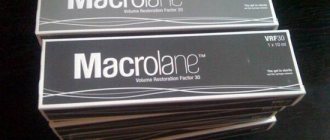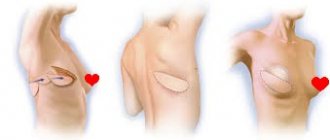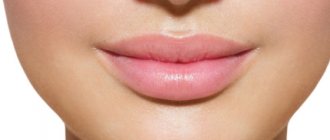Lipofilling - what is it?
The essence of fat injection (lipofilling, the term fat grafting is also used) is the transplantation of fat from areas of its greatest accumulation - such as the outer surface of the thigh - to places that lack volume. These include the face, arms, chest or buttocks. The advantage of this procedure is that it is completely safe and well tolerated by patients, moreover, the result has a long-lasting effect and looks natural. Every year, thousands of people choose lipofilling as an effective way to improve their appearance.
Fat transfer: pros and cons
• if your face has sunken areas or deep wrinkles; • to obtain a longer lasting effect from the operation than temporary fillers can offer; • to improve the contours of your body, hide scars, fill in hollows on the body or rejuvenate your hands and face; • during breast reconstruction to hide contour irregularities or obvious signs of breast implants.
Procedures related to fat transfer
Other procedures also associated with lipofilling include liposuction, buttock augmentation, the use of Botox or dermal fillers.
Advantages and disadvantages of lipofilling (fat tissue grafting)
Benefits of fatgrafting:
• using your own adipose tissue as a filler completely eliminates the possibility of an allergic reaction that can be caused by foreign substances; • the lipofilling procedure does not harm health in any way, and its results not only look natural, but are also more durable; • fat tissue transplantation allows you to rejuvenate facial skin using non-invasive techniques, in other words, damage to the skin is minimal.
Disadvantages of fatgrafting:
• it takes more time to prepare adipose tissue for transplantation than to work with a ready-made dermal filler; • Fat injections, while providing long-lasting effects that last longer than conventional dermal fillers, are slightly more expensive; • It may take several lipofilling sessions before your breasts or buttocks achieve the desired volume.
These basic factors will determine whether fat grafting is right for you or not. Its additional positive and negative aspects are determined by a plastic surgeon in each individual case.
About the technique
Fat grafting is a relatively new method, although it has great similarities with lipofilling. The essence of both operations is to carefully remove fat cells from certain areas of the body and inject them into parts in order to enlarge and model them. The sequence of these procedures is almost identical. So what is the difference between fat grafting and lipofilling?
It has long been clear to practical plastic surgeons that to replenish the volume of the face and/or buttocks lost with age, there is nothing better than one’s own adipose tissue. The poverty of lipofilling lies in two significant (as it turned out) problems:
- As a result of the collection of adipocytes from donor areas of the body and the subsequent process of their introduction into recipient areas, heterogeneous and relatively large fragments (lumps) are formed from the taken fiber. As a result, when transplanting it, difficulties arise, which force the use of cannulas with a large diameter and, to top it all, create significant pressure in the syringe. Thus, in the process of transferring fatty red goods, a large number of fat cells are destroyed, as a result of which the duration of the effect of the operation is insignificant.
- The tissue transferred to a new place must “take root”, because small vessels must regenerate in it, metabolic processes must be restored, etc. Although, as a result of the formation of heterogeneous lumps and damage to adipocyte membranes, mainly cells located in the thin peripheral layer survive these lumps.
That is why a consequence of lipofilling is the need to carry out an excessive (except for the planned) increase in volume (hypercorrection), which often leads to severe tissue edema. Most often, only two months after the operation, almost the entire volume of the injected fat tissue is destroyed. In addition, very often destroyed and reduced in volume lumps grow with rough connective tissue and turn into scar formations contoured by the skin.
Also in the section: Breast augmentation using lipofilling
Due to this, the fat grafting technique is fundamentally different from lipofilling not only in terms of gentle sampling, but also in subsequent processing to obtain grafts (particles, “droplets” of fat) of the required size. Depending on the size of these particles, American plastic surgeons divide the technique into three levels, which, in addition to the size of the fat “droplets,” differ in the following parameters:
- cellular composition;
- some features of the tools;
- technology for collecting donor textiles;
- methodology for preparing the latter;
- technique and level of adipose tissue injection.
For most patients, a multi-step approach is applied using all three levels. The fatgrafting levels are as follows:
- Skeletal or macrofatgrafting. It is carried out by using fat particles, which are large, but much smaller than those during lipofilling. This type allows you to successfully create or restore already lost volumes and figure in areas with good expression of subcutaneous fat. For example, it is perfectly suitable for facial correction by lifting or increasing the volume of the temporal, chin, cheekbone and cheek areas, increasing the volume of the buttocks or mammary glands, rejuvenating the forearms and hands, and shins.
- Microfatgrafting makes it possible to qualitatively even out the skin texture and fill delicate areas with volume in which the subcutaneous fat tissue is very small, thin, or even non-existent. This method corrects fine wrinkles, nasolabial folds, nasolacrimal grooves, shallow atrophic scars, stretch marks, and post-acne areas. Unless the previous level of fat crushing is used in these places, then such complications, purely unevenness, compaction, and lumpiness are practically guaranteed. (See the results of correction of nasolabial folds now using the proven method of lipofilling.)
- Nanofatgrafting is carried out with the smallest grafts. The technique is intended to (avoid improving the quality and increasing the density of the skin, as well as leveling its relief through the sensible superficial (intradermal) injection of adipose tissue in order to correct fine wrinkles of the face, neck and neckline area, periorbital zones, and general facial rejuvenation.
Fatgrafting of the face
After and after the buttock fat grafting procedure
Do you need fat grafting?
The main purpose of lipofilling is to add volume to those areas of your body that lack it. Most often, this procedure is used to correct the hands, face (including lips), sunken areas of skin (caused by liposuction or scars), as well as breasts and buttocks (increasing their volume). Of course, you must have enough fat tissue in your body for transplantation. It is extremely important that you do not have problems with blood circulation, various diseases or bad habits, such as smoking.
Facial lipofilling.
If your face has deep folds, for example, a pronounced nasolabial fold, laugh lines, crow's feet around the eyes, then fat tissue taken from the abdomen or thighs is used to correct these problem areas. This way you can hide acne scars, sunken areas of skin, and improve your lips and cheeks. Using fat injections, a plastic surgeon can easily correct the folds between the nose and mouth, reduce wrinkles on the forehead, and correct the contours of the face.
Breast augmentation.
Breast fat grafting is an excellent choice for those who want to slightly increase breast volume. However, the result will only be effective if your breasts already have a beautiful shape and good skin tone. Lipofilling is not suitable for significant breast enlargement, correction of its shape or skin tone. This is explained by the fact that your own adipose tissue may simply not be enough to fill it to the required volume.
A combination of breast implants and fat transfer.
Lipofilling will be appropriate if the shape of the mammary glands requires correction after implantation. For example, after surgery, irregularities may remain, which can be successfully hidden by fat tissue transplantation. This will give the breasts the ideal outline and optimal shape.
Breast reconstruction and fat grafting.
Lumpectomy, as a method of treating breast cancer, often leads to breast defects, which can be effectively corrected by fat grafting. In addition, fat grafting is one of the best solutions for complete breast restoration after mastectomy. In any case, achieving the desired volume may require 2-4 consecutive fat transfers.
Lipofilling and buttock augmentation.
Most patients dream of toned and rounded buttocks, which have already been called “Brazilian”. Using fat will allow you to get the desired result without the use of implants. In this case, liposuction is used not only to collect fatty tissue, but also to give the buttocks an appropriate shape.
Hand rejuvenation using fat grafting. Transferring fat tissue into the arms is an effective way to add volume to areas that have lost their elasticity and become wrinkled. The transferred fatty tissue also spreads to the underlying blood vessels and tendons, improving the quality of your skin for a long time.
If your overall health is satisfactory, and you have a positive attitude and a realistic outlook on things, then you are an excellent candidate for fat grafting.
Special technology
Mediaesthetic specialists have developed their own system for collecting and preparing fat cells for transplantation.
Through barely noticeable incisions in the donor area, the surgeon takes a pre-calculated volume of adipose tissue and injects it into the correction site, creating new shapes and contours of the body. Modern technology is called Micro Fat Grafting: fat cells are transplanted not in a “lump”, but in very small portions, in the form of beads arranged in a row, layer by layer. The absence of allergies and record-breaking survival times are the hallmark of the procedure. Lipofilling can be done anywhere where you need additional volume: breasts, buttocks, legs. Lipofilling also gives excellent results on the hands, smoothing out protruding veins.
Breast lipofilling
Breast lipofilling allows you to improve the shape of the mammary gland, give it a little extra volume, and restore its former elasticity. This procedure is suitable for women after sudden weight loss or breastfeeding. If significant breast enlargement is required, the operation can be combined with the introduction of breast implants - in this case, the most harmonious, natural results can be achieved.
Breast lipofilling is performed:
- As an independent method of breast enlargement by 0.5-1.5 sizes. An ideal option for those who fundamentally do not accept the installation of implants or have direct contraindications to such an operation.
- As a way to remove slight breast asymmetry without overall increasing its size.
- As an auxiliary procedure to improve the appearance of the patient’s bust after other surgical interventions.
- For correction of shape and size during complex plastic surgery on the tubular breast.
- As part of an operation to reconstruct the mammary gland after its complete removal, as well as to smooth out sunken scars and areas after sectoral resection and other manipulations performed in the treatment of oncological diseases.
- To camouflage a previously installed breast implant when contouring it.
Lipofilling of the buttocks
“Brazilian butt” is the dream of many, but very often even exhausting workouts do not help achieve the desired seductive shape. With the help of lipofilling, in just an hour it is possible to achieve what years of training could not achieve: rounded, elastic buttocks are obtained as if ordered. Lipofilling can be an excellent assistant during the buttock filament lifting procedure.
Lipofilling of the buttocks is used:
- As an independent way to enlarge the buttocks or correct their shape.
- As an additional procedure for correction of buttock replacement.
- To model an hourglass figure (fat from the back is removed and added to the buttocks area for contrast).
- With slight ptosis of the buttocks and retraction in the middle part.
Lipofilling of the legs
Another area of application for lipofilling is the legs. Thin legs sometimes seem not too even, and a very small increase in volume helps to delicately correct the problem: give the legs an elegant, even shape or eliminate an excessively wide gap between the thighs. In a word, to gain legs, which are usually called chiseled.
Contraindications
Lipofilling is not performed if the following factors are present:
- pathologies of the cardiovascular system
- metabolic disorders
- pregnancy and breastfeeding period
- tumors of various locations and origins
- ARVI and other infectious diseases
- diabetes
- disorders of the blood coagulation system
- Also, doctors do not recommend lipocorrection until the figure is fully formed (for girls this happens at about 25 years old).
Features of fat tissue transplantation
How does the fat transfer procedure - lipofilling - take place?
First, fat tissue is collected from certain areas of your body. It is then washed and cleaned. Specially designed needles allow you to quickly pump fat into those places that need to be given volume. Several similar procedures may be required to achieve the desired result. Fatgrafting can easily be described as a three-step process:
1 – collection of material; 2 – its cleaning and preparation; 3 – fat transfer.
Collection of adipose tissue. You and your doctor will select areas of the body to harvest fat and inject it under local anesthesia. Then the surgeon will make a small incision into which a cannula (a special tube for insertion into the cavities of the human body) connected to a syringe will be inserted using special sterile instruments. Using this combination, fat is carefully extracted (liposuction process).
Cleaning and preparation. Once enough fat has been collected, the surgeon will begin to process it and prepare the fat cells for transfer into small syringes, which will be used to make injections. Purification of fat tissue may require the use of a centrifuge or filtration to remove impurities.
Transfer. First, the area where the fat will be transplanted is prepared. Then a needle or cannula is inserted into a certain point. This procedure is repeated several times at different points in the same place. Each time the needle or cannula is removed, the grafted material is carefully inserted into the natural tissue. The process is repeated until the desired degree of correction is achieved and a mesh of transplanted fat is formed. Some doctors recommend massaging the areas that have undergone lipofilling. From their point of view, this helps to achieve the correct contour. Other experts prefer to rely solely on placement techniques in this matter. The surgeon may also apply a bandage or bandage to the graft site.
The main task of not only the plastic surgeon, but also the entire medical staff who works with you is to help you become even more beautiful, to make the result of the operation look natural. In addition, it is important that the experience associated with such procedures be successful and enjoyable.
Fat transfer: before and after photos
What options do you have?
Fat grafting uses your own fat tissue to correct the contours of your body, remove scars or fill in depressions caused by liposuction or cancer surgery, and rejuvenate your face and hands. Most often it is taken from the abdomen, sides, back of the arms, and thighs. Your plastic surgeon should discuss the following with you:
• into which areas the fat needs to be transplanted; • from which part of the body is it better to take it; • what additional procedures may be needed.
A – Adipose tissue can be taken from areas such as the buttocks or thighs. B – fat is transferred to the lips (as in the picture) or to any other place on the face.
What will the incisions and scars look like after surgery?
Scars can only appear at liposuction sites (where fat tissue was taken from). • Due to the fact that the incisions during liposuction are minimal, the scars from them are small. In addition, they are located in hidden places. Although sometimes, if adipose tissue is taken from more open areas, the scars are almost impossible to hide. • The number of scars and the degree of their scarring depends not only on the surgeon’s technique, but also on your genetic predisposition. • Most liposuction scars either disappear completely or become barely visible over time. Often, noticeable scarring occurs when large cannulas were used and because the patient has dark or dark skin. • There are two main types of marks that can be left on the skin after liposuction. The first one is a real scar. Another is dyschromia - a dark (hyperpigmentation) or light (hypopigmentation) spot on the skin.
Fatgrafting technique
Every year, the requirements for the quality of anti-aging procedures are increasing.
Aesthetic medicine methods are becoming more advanced and technologically advanced. Today we will talk about the fat grafting technique for anti-aging facial surgery. Our interlocutor is plastic surgeon Max-Adam Scherer .
— Doctor, how long has this technique existed in the world and when did you become acquainted with it?
The technique was developed by the famous American plastic surgeon Sydney R. Coleman.
. In July 2013, in Berlin there was a large Congress on regenerative plastic surgery and a combined course on fat grafting. That’s when I became acquainted with the fat grafting technique and successfully use it in my surgeries and rejuvenation procedures.
— Fat grafting is a relatively new method. Many have not heard of it, but is it so far from the well-known lipofilling?
Really,
We have long understood that there is nothing better than our own fat tissue to replenish lost volumes on the face. But the problem is that when, during conventional lipofilling, adipose tissue is taken and then injected, it forms heterogeneous large “lumps”. There are a lot of difficulties associated with this. It is difficult to insert such a “lump” - you need thick cannulas and pressure. With this injection, fat cells are damaged. Thus, during the transfer process, a large number of adipocytes (adipose tissue cells) die, the effect of the operation is short-lived.
Second point:
When the transplanted fat cell gets to a new place, it must take root and begin to breathe, eat, and remove metabolic products. To do this, vessels must approach it and “reanimate” the transplanted cells. It turns out that we introduce heterogeneous large lumps and those cells that are inside them die. Only a thin layer of cells at the periphery survives.
The surgeon is forced to overcorrect. For two weeks the patient has severe swelling and, in the best case, by the end of the second month there is almost nothing left of the injected volume. In the worst case, the collapsed lumps turn into fibrous tissue and contour like an internal scar.
— Then how is fat grafting fundamentally different from lipofilling?
Of fundamental importance is: careful harvesting of adipose tissue and grafts
To date, three levels of grafts have been introduced: nano-, micro- and structural fat grafting.
- Nanofatgafting
is often used in conjunction with plasma therapy for superficial subcutaneous administration to improve skin quality. - Microfatgrafting
is used on delicate areas with thin skin: periobital zone, lips, temples. - Structural fat grafting
uses particles much smaller than lipofilling, but still more than in the previous two types. It is good for increasing volume and lifting cheekbones, cheeks, chin, rejuvenating the hands, enlarging the buttocks and mammary glands.
— How is adipose tissue carefully “crushed” into such small particles?
For this purpose, special cannulas are used, invented by Sidney Coleman. He also developed a version of centrifugation in which the cells are not destroyed while in operation. Equally important is certain pressure parameters during fat aspiration so that the vacuum does not tear the membrane of fat cells.
— Does the centrifuge that is used for this have any special features?
There are parameters that must be observed: the time the material is in the centrifuge and the number of revolutions.
— Is liposuction performed as usual - using a vacuum method?
Depends on the task. In my practice, I introduce a tumescent solution (close to Klein’s solution). Then we collect adipocytes from the middle layer—the most viable cells. If you need to not only collect cells, but also perform liposuction, then I do it using any method and the second stage.
— How widely is fatgrafting used?
If you look at the world's leading surgeons, today almost any plastic surgery is either immediately or after some time supplemented with fat grafting. This gives a more natural effect, more noticeable rejuvenation. The fat cell is the cell of youth!
— Do you use fat grafting only on the face?
Yes, I work mainly with the face. Today, the level of aesthetic medicine and, accordingly, the level of patient requirements is quite high. It became clear that blepharoplasty does not properly rejuvenate the eyes - it only tightens the skin and removes hernias. But fat grafting can really enhance the effect of the operation to high-quality and visible rejuvenation of the entire area around the eyes.
— Do you need to remove a lot of fat to work on your face?
Usually 40-60 ml is enough. Where the fat comes from doesn't matter. Donor areas can be the stomach, hips, knees. Despite the small amount of adipose tissue required, this can be a problem for asthenic, thin patients. Then I prescribe them a “certain diet” and then do the procedure.
— In such asthenic people, doesn’t the transplanted fat disappear too quickly?
I instruct them to eat normally for six months, without strict diets, and to exclude active sports.
— Is fatgrafting a “stand-alone” technique or is it used as an addition?
As a single method, the effect of fat grafting is small. But if we take a young or intact face, then fat grafting can be used with thread lifts. For more invasive interventions (for example, UST lifting or oculoplasty) - as a complement and improvement of the effect of surgical rejuvenation.
— Why is it better to do fat grafting during blepharoplasty rather than repositioning your own hernias?
This is an individual question.
How severe is the problem, how mobile is the lower eyelid hernia. Sometimes it is difficult to reduce your own hernia due to various reasons. The hernial sac must be isolated, a pocket formed, moved and sutured. Therefore, in practice, relocation of hernias is rarely sufficient to replace lost volume.
— That is, during the examination you understand what to do for this patient?
I look at the initial anatomical data and can advise what is best. Every time I formulate an individual plan and it is always not one, but a combination of techniques. In addition, the plan will always be individual.
— Are there any features of rehabilitation after fat grafting?
I prescribe drugs to patients that increase oxygen consumption in tissues for 1.5 months; they promote good engraftment of transplanted fat cells. These drugs came to us from sports medicine. For those who exercise a lot, the cells experience oxygen starvation. In our case, the transplanted cells also experience oxygen starvation. If we increase the oxygen content, then we increase the survival rate.
— Does the fat grafting procedure increase the cost of surgery, for example, eyelid surgery?
Yes, by about 25%, during fat grafting special equipment and tools are used, the operation time increases by about 30 minutes, but, again, the rejuvenation effect is much more pronounced and lasting.
— Instead of fat grafting, is it possible to use fillers based on hyaluronic acid?
Filler based on hyaluronic acid is still an intradermal material. As with any temporary drug, an allergic reaction is possible. And then, this is just a gel layer, and fat grafting is a method of natural rejuvenation.
Thank you for your detailed story. There is very little information on new procedures and it is always very nice to hear an expert opinion first hand.
drscherer.ru
Preparation and performance of fat grafting surgery
Your surgeon will provide you with detailed instructions on how to prepare for your surgery. He will also answer any questions you may have, review your medical history, and conduct a physical examination to determine your readiness for the procedure. • You may be photographed before surgery. • Regardless of the type of lipofilling, sufficient fluid intake (hydration) is important both before and after the procedure. This will ensure a safe recovery and better results. In anticipation of your surgery, your doctor will ask you to: • stop smoking at least 6 weeks before the procedure to avoid poor wound healing and scarring; • refrain from taking aspirin, non-steroidal anti-inflammatory drugs, as well as vitamins and homeopathic remedies that can cause bleeding; • drink enough water before and after surgery for faster and more effective recovery; • make sure that someone is with you after surgery for at least the first 24 hours after the procedure.
What to expect on the day of fat transfer surgery?
The operation must be performed exclusively in a hospital or medical center with appropriate accreditation.
• The length of the procedure depends on how much fat is removed and the number of liposuction sites. For example, fat grafting on the face will require less fat than, for example, breasts or buttocks. • You will receive all the medications you need to ensure you are as comfortable as possible during surgery. Local anesthesia and intravenous sedation (sedation) are often used, but general anesthesia may also be required. • During the procedure, your heart function, blood pressure, pulse, and blood oxygen saturation will be constantly monitored using special monitors. • Your plastic surgeon will follow a surgical plan that he or she will discuss with you the night before your procedure. During the transplant itself, the doctor can make certain changes regarding the methods or techniques of lipofilling that will allow you to get a better result. The main thing is to trust your doctor and be calm. • After the procedure, you will be admitted to the rehabilitation department, where you will continue to be monitored. You may need to wear compression garments to prevent sagging skin after liposuction. Many patients say that in the areas from which the fatty tissue was taken, they felt pain, as if after an intense workout. • You will likely be allowed to go home after a short period of observation unless your surgeon suggests another option for post-operative recovery.
Postoperative care and recovery after lipofilling
Ask your doctor in advance how long it will take before you can return to your normal life and work. After surgery, you and your caregiver will receive detailed advice about post-operative care, including information about: • drainage, if one was installed; • normal symptoms you may experience; • any possible signs of complications.
How will you look and feel immediately after fat grafting surgery?
Your plastic surgeon will explain to you how to properly care for the areas from which the fatty tissue was removed. Recovery after lipofilling is an individual process and its program is developed depending on the type of operation. For example, this is how the process goes after facial fat grafting:
• during the first week the swelling and bruising will be so severe that you will not be able to see friends or colleagues; • in the second week the bruises will become almost invisible, but the swelling will remain; • on the seventh to tenth day you will feel a significant improvement, but you will still not be able to work in public places; • by the end of the third week, your previous appearance will return, and additional use of cosmetics will help hide the remaining signs of edema or bruises; • Once the major swelling has subsided, you will be able to appreciate the results of the surgery, but some swelling may persist for several weeks.
Features of the event
The main feature of the fat grafting procedure is the use of biological material obtained from the patient (fat cells). This approach guarantees absolute safety and success of the operation. Another important feature of the fat grafting procedure is the absence of scars or any other marks of the manipulations performed.
Fat grafting is a procedure that does not require hospitalization of the patient. The manipulations are carried out quickly, but in order to achieve the desired effect, it is necessary to follow some preliminary preparation recommendations:
- Before the operation, the patient undergoes a full medical examination, undergoes blood and urine tests, and receives consultation from specialists in order to exclude possible complications.
- The doctor takes a photo of the problem area and agrees with the patient on the desired contour and volume of the area to be corrected.
- Ten days before fat grafting, you must refrain from taking anti-inflammatory drugs, aspirin, homeopathic medicines, and vitamin complexes. It is also necessary to refrain from smoking and drinking alcoholic beverages.
The main stages of fatgrafting:
- Liposuction of fat cells. The extracted biological material is cleared of blood and tissue fluid. The specialist tries to preserve the maximum number of intact fat cells.
- In the correction areas, the doctor makes micro-incisions (size no more than 3 mm), through which filtered fat cells are carefully introduced in very small portions (0.1 ml). Fat layer by layer fills problem areas, eliminates defects, replenishing the missing volume.
- End of the procedure. A bandage is applied to the incision site, which is secured with a plaster.
Depending on the volume of fat being transplanted and the area of problem areas, the fat grafting operation lasts from half an hour to one hour.
Fatgrafting is performed under both general and local anesthesia. A special assistant monitors the patient’s condition so that nothing distracts the plastic surgeon from his direct duties.
How long will the effect of lipofilling surgery last?
You can expect that the areas where fatty tissue has been transplanted will become softer and more voluminous, leaving you looking refreshed and rejuvenated. You may also notice an improvement in the texture of the skin itself. • The longevity of the results of the operation depends on the skill of the surgeon, the method of collecting and cleaning the fat, as well as the location and method of transplantation. The skill of the doctor, based on experience and perfect knowledge of the fat grafting technique, is the key to a successful operation. • Microfatgrafting (one of the types of lipofilling), although considered a more labor-intensive process, provides a greater guarantee of an excellent result. • When the transplant is successful, the injected fat tissue receives new blood supply and nutrition from your body, which maintains its vitality. However, in rare cases, fat is rejected, so corrective procedures may be required. Keep in touch with your plastic surgeon Regular examinations and consultations with your doctor according to the schedule he has drawn up will not only preserve the results of lipofilling longer, but also your health.
Progress of the procedure
The procedure is usually performed on an outpatient basis under local anesthesia using intravenous anesthesia (medicated sleep). Through barely noticeable incisions in the donor area, the surgeon takes a pre-calculated volume of adipose tissue and injects it into the area in need of correction, creating new shapes and contours of the body. The procedure takes no more than two hours.
Rehabilitation
There are no special requirements for the recovery period. True, swelling may be observed for several days, but it quickly passes. There is no pain at all. After the procedure, you will have to wear compression garments for a while and forget about fitness for a while, but you will be able to amaze others with your new, beautiful silhouette the very next day after the operation.
Possible complications after lipofilling
Fortunately, fat grafting rarely causes serious complications. This procedure often takes place without any serious problems.
During your consultation with your surgeon, you should discuss the possible risks and complications of the surgery. Speaking of risks, they are the same for most surgical procedures. Possible complications after surgery may include: • adverse reactions to anesthesia; • hematoma or seroma (a collection of blood or other fluid under the skin that may need to be removed); • infection; • changes in sensitivity; • scarring; • allergic reactions; • damage to tissues or organs; • unsatisfactory result, which may require repeated procedures.
To protect yourself as much as possible from possible risks, you should strictly follow the advice and instructions of your plastic surgeon both before and after fat grafting.
Tags: plastic surgery
Market Analytics
- Black Lives Matter movement: reaction and consequences for the beauty industry
- COVID-19 is changing the rules of the game in the cosmetics market
- Beauty of the future: cosmetic innovations 2020
Convenient search for beauty salons on our website
Beauty salons in Moscow Beauty salons in St. Petersburg Beauty salons in Ekaterinburg Beauty salons in Novosibirsk
Latest blog posts on our website
- Naturecream / Apricot kernel oil for face
- Naturecream / MATRIXYL3000 - the best skin elasticity stimulator
- Naturecream / SPF in Natural Oils
- Naturecream / Geranium (Pelargonium) oil for skin health and beauty
- Prostye-sovety / Save on a beauty salon: procedures that can be done at home
- Naturecream / Growth Factor - brings back youth?
- Oksana-Lezina / 3 effective abdominal exercises from a fitness instructor for beginners
- Prostye-sovety / Making perfect curls at home
- Prostye-sovety / Which hair removal method to choose
- Naturecream / Wrinkles Puppets
Latest forum topics on our website
- Natalya / How to properly make a gelatin mask?
- Mrs._Smith / Badly sunburned! What to do?((
- Ice / Is it necessary to combine fitness classes with a diet?
- Antonova / What can be used for hair loss?
- Radio operatorKat / Who was on a protein diet?
Reviews about the procedure
Lipofilling (fat grafting) - fat transplantation [Leave a review]
Leave your feedback about this procedure (it will appear on this page after moderation)
In this form, describe only
your personal
experience of undergoing the procedure.
In order to leave a comment regarding the content of the article, use another form - in the “comments” block at the bottom of the page.
Other articles in this section
| Buttock lift with threads (filament lifting): features of the procedure, types of threads, their advantages and disadvantages Buttock lift with threads (filament lifting) is popular among girls who are dissatisfied with their shape. The effect is noticeable almost immediately and lasts for 2-3 years. The procedure is not long, it takes about 1 hour. Performed under local anesthesia. What other advantages does this method have, we will consider in the article. |
| Laser tattoo removal Tattoo ink is found under the top layer of skin, making it difficult to remove. Often several laser sessions or even surgery are required. |
| Removing stretch marks on the stomach About half of women who give birth face the problem of stretch marks on the stomach. If we add here women who are waging a persistent and irreconcilable struggle with excess weight, then this skin defect can be considered one of the most common reasons for contacting beauty institutes and cosmetology clinics. |
| Hand rejuvenation Hands are among those places where telltale signs of age become apparent first. Even if you've taken steps to keep your face and neck looking youthful, sun-damaged, veiny, wrinkled arms can make you look older than your age. There are a number of effective techniques for rejuvenating the hands, improving the quality and texture of the skin of the hands, while simultaneously reducing wrinkles and protruding veins. |
| Laser liposuction (laser lipolysis) Laser liposuction (laser lipolysis) is one of the methods for removing fat deposits, which, unlike classical liposuction, has low invasiveness, a short rehabilitation period and at the same time a good corrective effect. This method is quick to perform and does not require general anesthesia. Along with ultrasonic cavitation and cryolipolysis, it is considered an effective technique for removing cellulite. |
| Umbilicoplasty - navel plastic surgery Today, the number of people who want to give their navel an ideal shape has increased. For this purpose, plastic surgeons developed a special operation - umbilicoplasty, in other words, navel plastic surgery. In most cases, doctors have to remove the protruding navel or make it deeper and less noticeable, reducing its diameter. |
| Liposuction: what is it, types of liposuction, before and after photos Liposuction (lipoplasty, body contouring or body contouring) is a good alternative to grueling exercises and diets, with which you can get rid of fat in problem areas such as buttocks, abdomen, thighs , calves, ankles, chest (including men's), back, arms or neck. |
| Laser intimate rejuvenation: what it is, how it is carried out Modern cosmetology is replenished with more and more new types of procedures aimed at improving a woman’s appearance. Along with correction of facial skin and figure condition, attention has recently begun to be paid to delicate areas of the body. |
| Excessive sweating (hyperhidrosis or perspiration) Excessive sweating (hyperhidrosis) can be embarrassing and affect your personal and professional life, making it difficult to interact with others and causing you to avoid certain types of clothing and certain activities. There is a medical treatment for this disease, and you may also be prescribed special antiperspirants and even undergo surgery. |
| Abdominoplasty (tummy tuck) A tummy tuck, or abdominoplasty, can help create a flatter stomach by removing sagging aprons, excess fat and skin, and tightening the abdominal wall muscles. With its help, you can remove all or almost all stretch marks in the lower abdomen. A tummy tuck is often done after pregnancy, significant weight loss, or in cases where a flabby abdomen with weak muscles detracts from the overall appearance of the body. An additional benefit of abdominoplasty is the patient’s increased self-esteem. |
Fatgrafting: what is it, how effective is it and how is the operation performed?
Thanks to modern technologies and the latest plastic surgery techniques, today it is possible to correct any imperfections in appearance, not only of the face, but also of the body as a whole, without any problems.
One of these fairly popular methods of body correction is fat grafting or lipofilling, thanks to which in a fairly short period of time, you can change some areas beyond recognition, bringing them into ideal shape.
No artificial implants or chemicals, only natural and natural components for the body.
What is this
What is the fat grafting procedure? This procedure was first performed in the USA about 10 years ago, and today this technique is widely used in domestic beauty clinics. Its principle is to transplant your own adipose tissue from those places where there is an abundance of it, usually the abdominal area, to where it is lacking.
What problems does it deal with?
Most often, the fat grafting procedure is used for:
- correction of leg curvature;
- enlarging or changing the shape of the buttocks;
- increasing volume and adjusting breast shape;
- hand rejuvenation;
- eliminating wrinkles on the body and face;
- elimination of nasolabial or eyebrow folds on the face.
A similar technique is also used to correct certain areas of the body after injuries that have led to aesthetic deformation.
Advantages
The main and main advantage of this method of plastic body correction is the use of your own fat, not foreign fat. It does not require addiction, the body does not reject it, allergic reactions do not occur, and the patient does not require rehabilitation after such a procedure. It is also important that the so-called transplant “material” does not need to be looked for anywhere, the patient has everything available.
Some parts of the body are successfully reduced due to the first stage of the operation, while others acquire the desired volume. And all this is carried out through minimal surgical intervention, which practically does not cause stress and does not disrupt the natural life processes of the patient’s body. After the operation, there are no scars left, there are no painful or unpleasant sensations.
How quickly can you evaluate the results of lipofilling and how long does the effect last?
Based on the practice of carrying out such operations, it should be noted that in 70-80% of patients who used fat grafting, the transplanted fat cells successfully took root. The period during which the tissues take root completely ranges from one and a half to two months, but the first noticeable positive changes appear after three weeks. The final result, which will last for two years, should be expected in three months. If after the first procedure it was not possible to achieve 100% of the desired result, it can be repeated.
Features of fat tissue transplantation
The main feature of fat grafting is the use of the patient’s own biological material (fat cells). This ensures a high success rate of the operation and guarantees its complete safety, in contrast to plastic procedures that use foreign implants.
The final result also plays an important role; in most cases, the corrected parts of the body look natural, and do not indicate at all that a surgical intervention, albeit a small one, was carried out here. There are completely no scars or any other marks of the procedure.
Preparation and performance of the operation
Despite the fact that fat grafting is carried out quite quickly and does not require special hospitalization of the patient, this operation, like any other, requires preliminary preparation.
Firstly , a full medical examination is required, a general blood and urine test, and consultation with some specialists in order to completely eliminate possible complications after the procedure.
Secondly , the doctor will take several photos and agree with the patient what the contour of the corrected area should be. This is especially true in cases where microfat grafting is planned on the face.
Thirdly , before the procedure you should refrain from taking non-steroidal and anti-inflammatory drugs, any vitamins, homeopathy and aspirin. It is also advisable to quit smoking and alcohol within 2-3 weeks.
The first stage of the operation is liposuction of fat, after which it is cleared of blood and tissue fluid. At the same time, the specialist tries to preserve the maximum possible number of intact fat cells.
Next, small incisions are made in the corrected areas, their size is no more than 3 millimeters, and through them, the fat obtained after filtration is carefully injected in small doses (at least 0.1 ml) layer by layer in different directions, eliminating defective areas. Upon completion of the procedure, a special sterile bandage in the form of a patch is applied to the incision sites.
This procedure lasts from 30 to 60 minutes, depending on the extent of correction of defective areas and the transplanted fat.
The fat grafting operation can be performed under either local or general anesthesia. A specialist will monitor the patient’s condition and vital signs, while the plastic surgeon will begin his direct duties. During the operation, the preliminary action plan may be slightly changed, this is due to the physiological characteristics of each specific organism.
Postoperative care and recovery
After the operation, the patient will be monitored for some time, and painkillers may be used. It is noted that swelling and multiple painful hematomas most often bother patients in the places from which fatty tissue was extracted. To alleviate the condition, special compression garments can also be used.
Over the next three months, after fat grafting, any physical activity, massages of the areas being corrected, as well as going to the sauna, bathhouse, solarium and other thermal procedures are not recommended.
Complications
As a rule, fat grafting extremely rarely leads to serious complications. Most often they are limited to small edema, hematomas and seromas at surgical sites.
There may also be problems associated with:
- adverse reactions to anesthesia;
- allergic reactions to auxiliary medications;
- temporary changes in tissue sensitivity at the procedure sites;
- tissue scarring;
- tissue infection;
- unsatisfactory result.
Necrosis of injected fat cells is rare.
In order for the fat tissue transplant operation to be successful, without any negative consequences, you should seek such help only from qualified specialized medical institutions, and in no case use the services of dubious private clinics.











